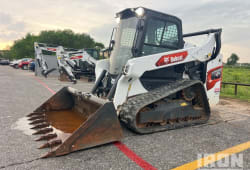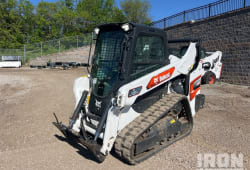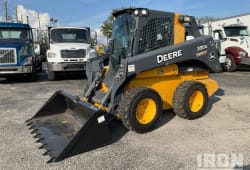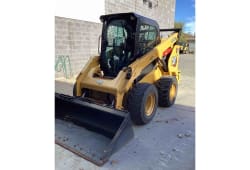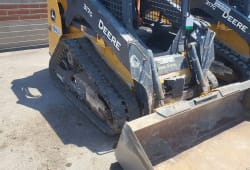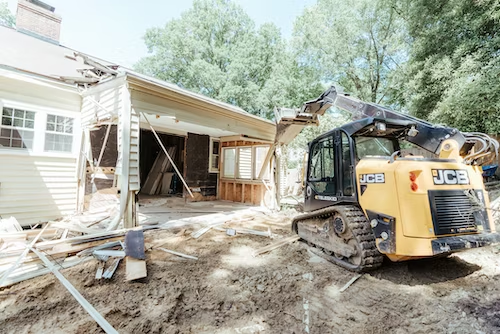Skid Steers: What Is It and How Is It Used?
10 Min read
)
September 16, 2023
In the realm of heavy machinery, the skid steer operates as an invaluable asset, adeptly handling numerous tasks across diverse industries. Whether you're a construction expert, a landscaper, or deeply invested in agriculture, understanding the ins and outs of the skid steer is essential.
Essentially, a skid steer loader is a multipurpose machine with a high operating capacity that allows you to perform various tasks. Manufacturers make them with a wide range of attachments like pallet forks and dozer blades, allowing them to complete the tasks of each respective piece of equipment.
What Is A Skid Steer?
:format(webp))
The skid steer, also known as compact track loaders or skid steer loaders, are compact, versatile construction machines designed for maneuverability in tight spaces while maintaining a high operating capacity.
These machines have a unique feature that sets them apart from other construction equipment: they can pivot their wheels independently, allowing them to turn within their own footprint.
This remarkable maneuverability makes skid steers invaluable when space is limited or precise movements are required.
Common Terms & Manufacturers
Within the construction industry, skid steer loaders may also be referred to by a few other terms. The most common alternative is simply "skid loader," highlighting the machine's primary function of loading and transporting materials. Less frequently, manufacturers with a dominant market share in a particular region might see their brand name become synonymous with the equipment itself. For example, "Bobcat" is a brand of skid steer loader, and in some areas, operators might use that term interchangeably with "skid steer loader." However, for clear and professional communication, "skid steer loader" remains the most universally recognized term.
Besides Bobcat, several other well-established manufacturers are renowned for their skid steer loaders. These include industry giants like Caterpillar (CAT), John Deere, and Case Construction Equipment. These companies offer a diverse range of skid steer models, catering to various needs in terms of size, power, and attachment compatibility. Additionally, brands like Volvo, Kubota, Takeuchi, and ASV are gaining significant recognition for their innovative skid steer designs and features. When choosing a skid steer loader, considering the reputation and expertise of these manufacturers alongside specific project requirements is crucial for optimal performance and value.
How Are Skid Steers Used?
A skid steer is a highly versatile machine used in various applications. For excavation and grading, it excels at digging, moving soil, and leveling terrain with precision. In material handling, its robust lifting capacity allows efficient transport of heavy materials like bricks and gravel. Landscapers use skid steers for tasks such as tree planting and stump removal, thanks to their maneuverability in tight spaces. In snowy regions, skid steers with snowplow or snow blower attachments clear driveways and sidewalks efficiently. In agriculture, they handle hay, manure, and livestock feeding. For demolition, they can be equipped with hydraulic breakers or grapples to break concrete and manage debris. On construction sites, their compact size and agility are perfect for digging foundations, lifting materials, and general cleanup.
Major Components of a Skid Steer
Understanding the major components of a skid steer is crucial for both operators and potential buyers.
Engine: The heart of the skid steer, the engine provides the power necessary for all operations. A skid steer can be powered by diesel or gasoline engines, and in recent years, some models have even embraced electric or hybrid power sources.
Hydraulic System: They rely heavily on hydraulic systems for controlling attachments and performing various functions. These systems consist of pumps, cylinders, and hoses that enable precise control of movements.
Wheels or Tracks: They come in two primary configurations: wheeled or tracked. A wheeled skid steer is ideal for smoother surfaces, while a tracked skid steer offers better traction and stability on uneven terrain.
Operator Cab: The skid steer cab is where the skid steer is controlled. Modern skid steer cabs are designed for comfort and safety, featuring ergonomic seats, joystick controls, and climate control options.
Attachments: A skid steer is known for its ability to use a wide variety of attachments, such as buckets, forks, augers, and grapples. These attachments can be quickly swapped out, transforming the skid steer into a versatile tool for different tasks.
:format(webp))
Industries That Rely on The Skid Steer
Many industries rely on the skid steer due to their adaptability and efficiency. Some of the sectors that heavily depend on the skid steer include;
Construction
They're essential on construction sites, helping with digging, lifting heavy stuff, and clearing debris. Their small size and weight make them perfect for tight spots, like city construction sites.
Landscaping and Grounds Maintenance
Landscapers use a skid steer for various tasks, including grading, trenching, and tree removal. Their ability to work in tight spaces makes them ideal for maintaining lawns, gardens, and parks.
:format(webp))
Agriculture
Farming uses a skid steer for tasks like loading and unloading materials, moving hay bales, and cleaning barns. Their versatility makes them a valuable asset on the farm.
Snow Removal
In regions with cold winters, a skid steer is equipped with snowplows or snow blowers to help efficiently clear roads, parking lots, and sidewalks.
Demolition and Waste Management
Skid steer models equipped with hydraulic breakers or grapples are employed in demolition projects and waste management operations. They can handle concrete demolition and debris removal with ease.
:format(webp))
Types of Skid Steer
The skid steer comes in various types, each tailored to specific needs. They can be divided into two primary categories: skid steer sizes and the types of wheels.
Small Frame Skid Steers
Small frame skid steers are compact and lightweight, making them perfect for tasks that take compact equipment or require maneuverability in tight spaces. This makes the small frame skid steer loader extremely popular in landscaping, where it is essential to get the job done without damaging the job site.
A good example of smaller skid steer loaders are John Deere skid steers and the Bobcat skid steer. These skid steer loaders often have a lower operating capacity (less than 1,750 lbs) but excel when size is critical.
:format(webp)) Medium Frame Skid Steer
Medium Frame Skid Steer
Medium frame skid steers offer a balance between size and power. They generate between 50-70 horsepower and have a rated operating capacity (ROC) ranging from 1,750 to 2,200 pounds.
This increased capacity allows them to tackle a wider range of projects, including light excavation, material handling, and light grading.
Large Frame Skid Steer
Large-frame skid steers are more robust and offer more than 70 horsepower and higher operating capacities. A larger skid steer is more suited for heavy-duty tasks that require a higher lift capacity and moving substantial loads.
Large framed skid steers are larger, providing stability and power for demanding applications. They have a much higher rated operating capacity, over 2,200 lbs, meaning they are able to take on harder tasks and carry larger loads.
This is especially important if you're using your skid steer in forestry or on a construction site.
Wheeled Skid Steer Loader
Wheeled skid steers are equipped with four wheels and are designed for use on smoother surfaces. They are ideal for construction sites with paved or gravel surfaces, where speed and maneuverability are essential.
:format(webp))
Tracked Skid Steers
Tracked skid steers have rubber tracks that provide superior traction and stability, making them suitable for rough or muddy terrain. They are commonly used in agriculture, forestry, and landscaping.
Vertical Lift vs. Radial Lift
A skid steer can also be categorized based on its lift mechanism. A vertical lift skid steer provides a straight up-and-down lift path, maximizing reach and lift height, making it ideal for tasks like loading trucks and stacking materials. In contrast, a radial lift skid steer follows a curved lift path, better suited for digging and excavating, making it perfect for construction and digging applications.
Skid Steer Attachments
One of the most appealing features of skid steers is their ability to accept a wide range of attachments. These attachments enhance the machine's versatility and allow it to perform various tasks without the need for multiple specialized machines. Here are some common skid steer attachments:
Bucket: The standard attachment for a skid steer, buckets are used for digging, lifting, and transporting materials. Typically buckets are slightly wider than the track or wheel base. Buckets come in varying sizes and what size you use might vary depending on what material you're handling.
:format(webp))
Forks: Fork attachments are used for handling pallets and other materials, making them suitable for warehouse and construction site applications.
Auger: Auger attachments are used for drilling holes in the ground, making them valuable for tasks like fence post installation or tree planting.
Grapple: Grapple attachments can pick up and handle bulky or irregularly shaped materials, such as logs or debris.
Sweeper: Sweeper attachments are used to clean streets, parking lots, and other paved surfaces by removing debris and dirt.
Trencher: Trencher attachments are designed for digging trenches quickly and efficiently, often used in utility and irrigation projects.
Snow Blower: Snowblower attachments are essential for snow removal in areas with heavy winter snowfall.
:format(webp))
New vs. Used Skid Steer
:format(webp))
When considering the purchase of a skid steer, one important decision to make is whether to buy new or used equipment. Both options have their advantages and disadvantages, but let's explore why a used skid steer can be a cost-effective choice:
Cost Savings
A new skid steer comes with a premium price tag, while used ones are often significantly more affordable. This cost savings can be especially attractive for small businesses or operators on a budget.
Depreciation
Like all vehicles and machinery, a skid steer depreciates over time. Purchasing a used skid steer avoids the initial depreciation hit that new equipment experiences.
:format(webp))
Proven Reliability
Many used skid steers have already proven their reliability and durability through years of service. A well-maintained used skid steer can provide reliable performance for many more years.
Wide Selection
The used skid steer model market offers a wide selection of skid steer models, allowing you to choose a machine that fits your specific needs and budget.
:format(webp))
Resale Value
If you decide to sell your used skid steer loader in the future, its resale value will likely be more stable than a new machine, which experiences rapid depreciation in the first few years.
Financing Options
A used skid steer may have more flexible financing options, making acquiring the necessary equipment easier without a substantial upfront investment.
Skid steer loaders are versatile workhorses that play a crucial role in various industries thanks to their maneuverability and adaptability. Understanding the different types of skid steer, their major components, and the vast array of attachments available can help you make informed decisions when selecting the right size skid steer or machine for your needs.
When it comes to purchasing a skid steer or other vertical lift machines, considering the cost savings and benefits of buying used equipment can be a smart choice for many operators and businesses-allowing you to pick the right skid steer size for your operation without worrying about the cost.
Find the best used skid steer loaders today at Boom and Bucket, where we feature the best range of used small, large, and medium frame skid steers on the market.



